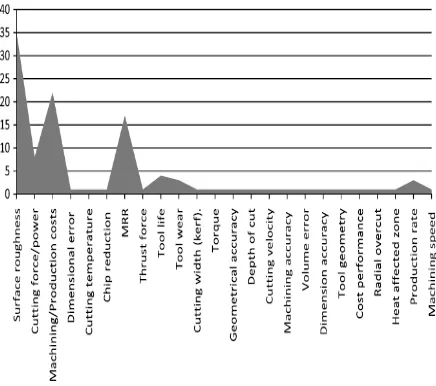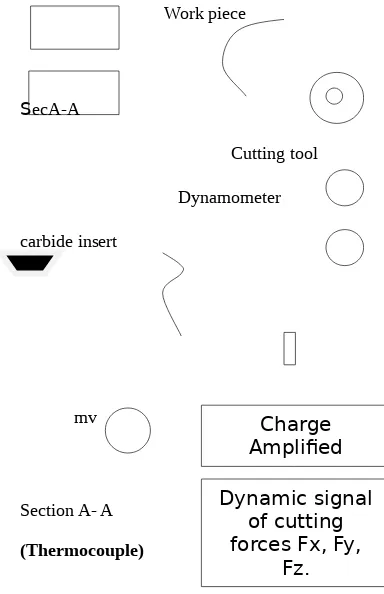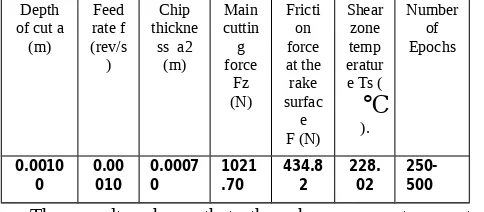iDECON 2012 – International Conference on Design and Concurrent Engineering Universiti Teknikal Malaysia Melaka (UTeM)
1516 October 2012
Artificial Immune System (AIS) Algorithm For Optimizing Shear Zone
Temperature In CNC Turning Operation.
Adnan, J.A.
1, Mohamad, B.M.
2and Md.Nizam, A.R.
31,2,3 Faculty of Manufacturing Engineering,
Universiti Teknikal Malaysia Melaka, Durian Tunggal, 76100 Melaka, Malaysia
Phone: +606-3316002, Fax: +606-3316411, Email: [email protected]
1Email: [email protected] 2Email: [email protected] 3Email: [email protected]
Abstract - The temperature in metal cutting operations is a result of heat that influences the cutting tool properties such as tool durability. It is necessary to investigate this parameter and reduce it to the lowest possible value. This study deal with the shear zone temperature (Ts) and its effect on the mechanical properties of the carbide insert cutting tool in (CNC) turning operation using dry machining. An Artificial Immune System (AIS) algorithm is proposed as the optimization algorithm to find the optimum cutting parameters that minimize the shear zone temperature. Therefore, the tool durability can be enhanced. The optimum parameters are used directly in (CNC) turning machine as inputs to find the corresponding cutting tool temperatures. Many sensors and devices were used, thermocouple for temperature measuring, dynamometer for cutting forces measuring, signal processing interface and intelligent decision making strategies. Finally, the ideal network can be used directly (on-line) on CNC turning machine to become a suitable guide of cutting tool temperature.
Keywords- Artificial Immune System (AIS) algorithm; shear zone temperature (Ts); carbide insert cutting tool; computerized numerical control (CNC) turning machine; Temperature and force sensors.
I. INTRODUCTION
The cutting tool condition is affected by temperature which relies on many parameters. Generated high temperature affects on the work piece and cutting tool properties and then increases the cutting tool wear and reduce the tool life, therefore, it is necessary to reduce the amount of this heat as low as possible. The total work done by cutting tool to remove metal is converted into heat which is converted into the chip, tool and work piece material. The major amount of the heat is extracted by the chip but it does not matter because chips are thrown out, so the attempts should be made such that the chips take away more and more amount of heat leaving small
amount of heat to damage the tool and work piece [1]. Three areas of heat generation can be distinguished in turning operation, a shear zone, chip-tool interface zone and tool-work piece interface zone. It can be noticed that the shear zone temperature affects the mechanical
properties of the work piece-chip material [2]. AIS
algorithm is used to find the optimum cutting parameters that help in decreasing the shear zone temperature based
on theclonal selection and affinity maturation principles
of the immune system.
There are many previous studies showed a good result about temperature effects on cutting operation. In [3] it is showed that the tool wear generally considered to be a result of mechanical (thermo dynamic wear like abrasion) and chemical (thermo chemical wear like diffusion) interactions between the cutting tool and work piece and the appearance of the chemical wear become clearer especially when the speeds move into the high-speed-cutting range.
Paper [4] studiedthe tool-chip interface temperature
during turning of EN-31 steel alloy with tungsten inserts at different parameters using a tool-work thermocouple technique. The results showed that the increasing in cutting speed, feed rate and depth of cut led to increase the cutting temperature, while increasing nose radius reduced it. The author concluded also that the total wear rate and crater wear on the rake face are strongly
influenced by the temperature at chip-tool interface. The
No
Yes
Initialize antibodies randomly
Affinity evaluation of antibodies
Mutate cloned antibodies Select n antibodies from
population
Clone antibodies to produce cloned antibodies
Stopping Criteria reached? Affinity evaluation of
mutated antibodies
Select n antibodies from mutated antibodies
Combine selected antibodies and new
antibodies
Generate new (d) antibodies
randomly
mutated
antibodies
Endart
Start
piece surface safety and machining accuracy. Paper [6]
showed thatthe depth of cut has the greatest influence on
temperature when turning hardened steel using multilayer
coated carbide tools at high cutting speeds. Finally, The
cutting tool temperature if not controlled properly cutting tool will undergo for severe flank wear , notch wear , loose sharpness of the cutting edge , become blunt by welded built –up edge and weaken the product quality [1].
Motivation of the study
There are three motivations for this study; the first one is the handbook recommendations or human experience which is used to select convenient machine parameters in manufacturing industry. These may not guarantee the optimum performance and minimization of costs. Another motivation is that the high temperature generated leads to many problems like chip and built-up-edge formation, reducing the shear strength, dimensional inaccuracy of the work piece, surface damage by oxidation, rapid corrosion and burning, rapid tool wear which reduce tool life, plastic deformation of the cutting edge, thermal flanking and fracturing of the cutting edges due to the thermal shocks. The third motivation is because of most optimization algorithms are concentrated on optimization surface roughness followed by machining/production costs and material removal rate and there are very few studies dealing with the cutting temperature [7] as shown in Figure 1.
Fig.1. The percentage of papers which study the cutting temperature.
The temperature effects shear zone on the mechanical properties of the work piece-chip material [2], this study aims to minimize operation of this temperature using AIS algorithm.
II. METHODOLOGY AND APPROACH
A. Artificial Immune System
The algorithms typically exploit the immune system's characteristics of learning to solve a problem. This algorithm includes three basic mechanisms, proliferation of cells to make antibodies against the antigen, generation of diverse antibodies to achieve affinity maturation through somatic hyper mutation process, and antigenic receptors handling which has low affinity. Artificial immune system algorithm methodology is shown in Figure 2.
B. Objective function
The objective function of this study is used for minimizing the shear zone temperature (Ts) where the major part of the energy is converted into heat as shown in (1) [8]:
Ts =
B . C . Vc .(a
2
. Fz−F . f .
sin
ф)/a
2
J .θ . f . Vc . a
+ Ta(1)
Ts:- Shear zone temperature (
℃
).B:- Shear energy that is converted into heat = (0.95 ~ 1) in turning operation.
C :- Heat that goes from the shear zone to the chip = (0.7 ~ 0.9) in turning operation.
Vc :- Main cutting velocity (m / min). a2:- Chip thickness (m).
Fz:- Main cutting force (N).
F: - Friction force at the rake surface (N). f :- Feed rate (m / rev).
ф
:
−
cutting tool edge angle
(Degree). J:- Mechanical equivalent of heat of the chip / work material (dependent on workpiece material).θ
:- Volume specific heat(
dependent on workpiece material)
a :- Depth of cut (m) .
Ta:- Ambient temperature = 25
℃
.
C .The constraints
Depth of cut (a), feed rate (f) , chip thickness (a2), main cutting force (Fz) and friction force at the rake surface (F) mainly affect on the operation temperature, therefore it should be taken as constraints as in (2), (3),(4),(5),(6)
a min ≤ a ≤ a max (2)
f min ≤ f ≤ f max (3)
a2 min ≤ a2 ≤ a2 max (4)
Fz min ≤ Fz ≤ Fz max (5)
F min ≤ F ≤ Fmax (6) The objective function and the constraints should be used in AIS algorithm to find the optimum cutting parameters that help in shear zone temperature decreasing in turning operation. The flow chart to minimize the shear zone temperature using AIS algorithm is shown in Figure 3.
Start
Input Ts =
B . C . Vc .(a
2
. Fz−
F . f .
sin
ф)/
a
2
J .θ . f . Vc . a
+TaInput constraints
a min ≤ a ≤ a max f min ≤ f ≤ f max a2 min ≤ a2 ≤ a2 max Fz min ≤ Fz ≤ Fz max F min ≤ F ≤ Fmax
Find the optimum parameters
Find minimum value of (Ts)
No
Yes
Enter the optimum parameters to CNC turning machine
Find the actual cutting temperature
Comparison between the theoretical and actual cutting temperature
Find the optimum (AIS) algorithm Stopping Criteria
Charge
Fig.3. Flow chart to minimize shear zone temperature using AIS algorithm.
When the operation of finding the optimum cutting parameters by AIS algorithm finishes using stopping criteria which achieve minimum shear zone temperature, it can be used as inputs to the CNC turning machine to find the shear zone temperature. The results will collect and the ideal algorithm which achieved optimum cutting parameters and minimum shear zone temperature will be selected as intelligent guide for CNC turning machine using on-line pattern.
D. Experimental setup (Hardware)
The experiment devices and tools used to find the actual results on CNC turning machine in this work are:- (i) CNC turning machine.
(ii) Carbide inserts as turning cutting tool.
(iii)Work piece material.
(iv) Thermocouple for temperature measurement. (v) Dynamometer for cutting forces measurement.
The experimental setup is shown in Figure
Work piece insert cutting tool were taken to achieve the experiment. The magnitudes of the variables are being assumed with constraints while the constants were taken from standard machining handbooks. The main cutting velocity (Vc) is set as 125.6 m/min, volume specific heat θ = 825
cal/m3/Co for mild steel material
,
cutting tool edgeangle ф is set as 20º
,
mechanical equivalent of heat ofthe chip J= 4.2 J/Cal for mild steel, ambient temperature Ta = 25ºC. The constraints of variables taken as
0.001 m ≤ a ≤ 0.003 m 0.00010 m/rev ≤ f ≤ 0.00012 m/rev 0.0006 m ≤ a2 ≤ 0.0008 m 1000 N ≤ Fz ≤ 1200 N 400 N ≤ F ≤ 500 N
After using the above parameters in AIS algorithm by the objective function the following results have been obtained.
III Results
The maximum number of generations (500) and the
population size (30) are selected, then the ideal cutting parameters and corresponding shear zone temperature for
the optimum iteration will be obtained as shown in Table
1.
Table 1. Ideal cutting parameters and corresponding shear zone temperature.
The best objective value (minimum shear zone temperature Ts) is represented by performance and equal to 228.028 ºC. This value occurs at the iteration 250-500 as shown in the diagram represented by Figure 5.
Depth
3 0.00010 0.00071 1115.14 498.817 266.07 6-25
0.0010
2 0.00010 0.00071 1033.29 439.736 232.459 52-249
0 50 100 150 200 250 300 350 400 450 500 (minimum) shear zone temperature) is shown in Table 2.
Table 2. The ideal cutting parameters
The results show that the shear zone temperature decreases with reducing the value of the depth of cut (a) and main cutting force (F), while the feed rate (f) has not significant effect on the shear temperature. Also it is shown that the depth of cut has the greatest influence on temperature.
IV Conclusion
In many real applications the makers face the problem of simultaneous optimization of several conflicting and incomparable objectives. The cutting temperature if not controlled properly, cutting tool will undergo for severe flank wear , notch wear , loose sharpness of the cutting edge , become blunt by welded built –up edge and become blunt by welded built –up edge and weaken the
product quality. The most optimization algorithms
considered by the researchers at the last time are concentrated on optimization another parameters and there are very few papers to study the cutting temperature. Therefore, this study discussed about the optimization process of the shear zone temperature in CNC turning machines using (AIS) intelligent algorithm which used
(CLONALG) terminology such as antibody, antigen and clonal that is directly derived from the immunology term. The results were reasonable and can be developed using other modern heuristics algorithms like bat algorithm, monkey search and spiral optimization. Finally, the ideal network can be applied on the CNC turning machine directly using on-line pattern.
ACKNOWLEDGMENT
Special thanks go to the manufacturing and conference teams.
REFERENCES
[1] Md. Abdulla Al Masud ,Syed Mithun and Nikhil Ranjan Dhar “Modeling of chip Tool Interface Temperature in Machining Steel – An Artificial Intelligence (AI)Approach,” Department of Industrial and Production Engineering – Bangladesh International Conference , pp. 22-24, (2011).
[2] D. O Sullivan and M.Cotterell ,“Temperature measurement in single point turning,”Cork Institute Technology, vol.118, pp. 301-308, 2001.
[3] S. Dolinšek and J. Kopac “Mechanism and types of tool wear; particularities in advanced cutting materials,” Journal of Achievements in Materials and Manufacturing Engineering, vol.19, pp. 11-18, 2006.
[4] L.B. Abhang and M. Hameedullah “Chip-tool interface temperature prediction model for turning process,” International journal of English science and technology , vol.2 , pp. 382-393 , (2010).
[5] Milenko Sekulić, Marin Gostimirović, Pavel Kovač, Borislav Savković and Zoran Jurković, “Optimization of cutting parameters based on tool-chip interface temperature in turning process using Tagugi’s method,” 15th International Research/
expert conference, pp. 69-72, (2011).
[6] Federico M. Aneiro, Reginaldo T. Coelho, ndLincoln C.Brandão“Turning Hardened Steel Using Coated Carbide at High Cutting Speeds,” , vol.30, (2008).
[7] Norfadzlan Yusup,Azlan Mohd Zain and Siti Zaiton Mohd Hashim, ,“Evolutionary techniques in optimizing machining parameters: Review and recent application (2007-2011),” Expert systems with applications, Malaysia, vol.39 , pp. 9909-9927, (2012).
[8] Kharagpur, e-Book ,“Cutting temperature causes, effects, assessment and control,” Lesson 11, Module2 of mechanics machining, Indian Institute of technology , V2 ME IIT,2009.
[9] Ramon Quiza,Marcelino Rivas Santana and Eleno Alfonso Brindis ,“Genetic algorithm-based multi-objective optimization of cutting parameters in turning processes,” Engineering Application of Artificial Intelligence, vol.19, pp. 127-133, (2006).
Fig.5. minimum shear zone temperature (Ts)


